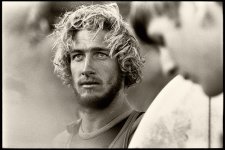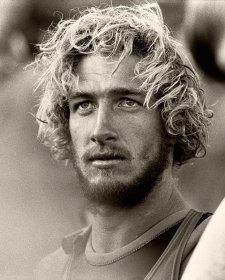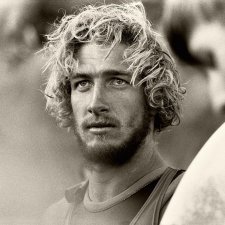One night in the spring of 1970 in an old house in Whale Beach, north of Sydney, John Witzig, Albe Falzon and David Elfick put together the first issue of Tracks, playing Neil Young’s album Harvest over and over again as they pasted up galleys of type. Witzig had been the editor of a magazine called Surf International, Falzon had been at Surfing World and Elfick was an editor of the pop newspaper Go Set before they formed the pioneering Tracks triumvirate. Amazingly, after a few issues they convinced Consolidated Press to distribute the magazine, which was in a tabloid newspaper format, mostly black and white with the addition of a single colour to the cover, reprised in advertisements toward the back of the publication (the first issue featured thrifty highlights of brown, the second orange, the third green.) The centrepiece of the first issue was a photograph Witzig had taken of factory chimneys blurting smoke in Newcastle; it heralded his ongoing editorial focus on environmental issues. Surfer Nat Young ended his first article for Tracks, excoriating the established Church, with a reckless sentence that echoes through the exhibition Arcadia : ‘By simply surfing we are supporting the revolution.’
Young’s rallying cry – still seeming, somehow, as plausible as it’s preposterous - allows considerable leeway in interpretation. Freedom of interpretation is fundamental to the exhibition Arcadia, which sets out to offer much to buoy, but little to guide, the visitor. Bearing in mind that every image in it, and every moment of film, has been chosen for its beauty and vitality, the visitor is free to interrogate anything in the exhibition for its further meaning and ramifications. However, the show isn’t a history of Australian surfing; there are key figures who aren’t in it, and minor figures who are. It’s not an exercise in where-are-they-now. It’s not a history of Australian self-sufficiency or cottage industry, or the urge to leave the cities for a more fundamental, healthy life. It’s not a social history of Australia in the seventies. It doesn’t comprise a collection of kitsch or a glossary of the slang of the day. All the missing facts, unless they’ve been guarded by the individuals involved, can be found in various good books and websites. Arcadia is anti-didactic for anything else would be contrary to the spirit of its content.
All possible themes of Arcadia are indicated by the excerpts from Surf International, Tracks and SeaNotes in this catalogue, and the pages from these journals that are distributed throughout the exhibition. Many of the photographs in the show were taken for, or first published in, those magazines (and have been reprinted, under Witzig’s supervision, to unprecedented size). Witzig filed his negatives fairly conscientiously from about 1971. Falzon didn’t; and now, he’d rather go surfing any day than look for them.
Surf International, published in 1969 and 1970, really was mostly about surfing; it was Australian, but its international ambition occasioned the publication of some good articles about unsophisticated people searching the globe for unpopulated waves. They were always ready to be delighted; but their cars always broke down, and good surf never could - nor can - be relied upon. Tracks in the Witzig-Falzon-Elfick era of 1970-1972 was credibly characterised recently as ‘maybe the hippest youth culture magazine being published in the world at the time’. It ran plenty of articles about surfing, but just as many about environmental sustainability (as we’d now call it), architecture, food, music and miscellaneous initiatives opposing conformist, competitive ways of living in a burgeoning capitalist country. Witzig’s most ambitious periodical venture, SeaNotes, which ran from 1977 to 1978, ran opinion pieces on surfing but also on Australian party politics, Aboriginal affairs, apartheid, Jim Cairns’s Confest, sport, the environment and wine by writers and photographers including Mungo MacCallum, Thomas Keneally, Rennie Ellis, Greg Weight and Anders Ousback. Phil Jarratt described it recently as a Tracks for grown-ups, in which Witzig, characteristically, over-estimated the intellectual needs of his intended readership; certainly, he interviewed Margaret Throsby at length in it in the autumn of 1978. Throughout these three publications, attempts to describe the interaction of ocean and individual recur; Wayne Lynch is the most convincing, perhaps, on the topic of how the blessings and hard lessons imparted by the ocean augment the resilience of the man on land.
If it’s about anything, Arcadia is about how it feels to be lean, male, strong, untrammelled and irresponsible: to be a slacker with immense discretionary energy. Almost all the people represented are handsome youths. Indeed, the exhibition is a tribute to the physical bravery, beauty and ebullience of many young men – which is unusual in a show that isn’t about war (although it’s true that conscription shadowed many of the individuals pictured, and many whole bodies like theirs ended up punctured and ripped up in Vietnam). Through photographs, film and text, their free-spirited, passive-revolutionary character shines. The ocean may not appear in all of the images; in fact, it’s absent from at least half of them, as well as from most of the film footage; but you can hear it, as it were. The exhibition as a whole – comprising pictures of people, pictures of houses, pictures of banksias, heath and driftwood, pictures of campgrounds - is underpinned by a Romantic conception of the awesome and spiritually restorative force of the sea.
Nicholas Harding’s intricate recent drawings of the trees, rocks and water of the north coast of New South Wales are the surprise inclusion in this National Portrait Gallery exhibition. By his own description, Harding’s relationship to the works is physically and imaginatively intimate; it’s empathic, symbiotic, manic, therapeutic; but let’s not call them self-portraits. From his studio in inner Sydney, Harding regularly heads north to the surf, where, borne up or pummelled, he detaches from works he’s finished and cogitates works he’s yet to begin. He happens to haunt the region around Angourie, where many of the photographs in the exhibition were taken. Suggested, initially, by Witzig’s, Falzon’s and Harding’s common love of a stretch of coastline, and encouraged by the resemblance of Nat Young’s hair, in Falzon’s photograph, to fibrous vegetation, the selection of Harding drawings emphasises the texture of the photographs and harmonises with their vigorous, yet gentle, sensibility. Look for the twisting forms; for the prop-roots and branches that look like tangled, salty locks; and simply for the lads having fun. Apart from the fact that they allow Witzig’s and Falzon’s portraits from the 1960s and 1970s to be viewed in a fresh contemporary context, Harding’s fantastically detailed, intensely rendered pandanus, rock and scrub drawings express his profound holistic commitment to the artwork. It’s an aspect of his practice that any of the soul-surfers represented in the exhibition would respect.
In ancient Greece, the theme of an innocent, fundamental habit of living didn’t surface in art until the cities were big enough to support both jaded, harried consumer-citizens craving expression of such a conception, and a critical mass of poets to satisfy their imaginative needs. Only those alienated by time and distance from rustic life can develop a wistfulness for it; only in the third century AD did a poetic genre based around the simple customs and unspoiled country of regions such as Arcadia or Magna Graecia (now Sicily) - inhabited by shepherds, bards, nymphs and pipers - develop. Clearly, in Australia at the end of the 1960s, a time of yearning for ingenuous ways had come around. This exhibition takes a punt on the idea that it’s come around again.
The works in Arcadia have been brought together not so much to evoke ideas, as to evoke a sensual response: to salt and fresh water, wet and dry sand, dune vegetation, undergrowth, tent canvas, floors of vans and shacks, weatherboards, hand-knitted jumpers, thin old t-shirts, corduroy, spongy neoprene, stiff hair, dog fur, noses and claws, banksia pods, firewood, seaweed and rocks. If you can feel any of those textures, if you can smell or taste any of those odours - and if, senses sharpened, you can feel a seed of independence germinating within you - Arcadia lives in you. By simply coming to Arcadia to look at pictures of surfers, you’re acknowledging the possibility of revolution.
Sources
John Roberts, ed. Oxford Dictionary of the Classical World. Oxford: Oxford UP, 2007.













